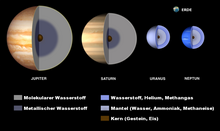Metallisk hydrogen

Metallisk hydrogen er en degenereret fase, hvor hydrogen er elektrisk ledende og har andre metalliske egenskaber som høj refleksionsevne. Fasen antages at eksistere ved tryk over 400–500 gigapascal (GPa) i store gasplaneter som Jupiter og Saturn.
Tilstanden blev først teoretisk forudsagt af Eugene Wigner og Hillard Bell Huntington i 1935, som beregnede at hydrogen ville blive metallisk ved et tryk på omkring 25 GPa.[1] Senere beregninger er kommet frem til at faseovergangen ikke indtræffer før ved 400–500 GPa,[2][3] som er højere end trykket i Jordens kerne (360 GPa).
Siden 1996 er der blevet gjort flere forsøg på at påvise metallisk hydrogen eksperimentelt. I 2011 meldte forskere ved Max Planck-instituttet for kemi, at de havde observeret noget som virkede som en faseovergang til metallisk hydrogen ved et tryk på 260–300 GPa,[4] men der kom flere indvendinger mod eksperimentet og en gruppe ved Carnegie Institution for Science fandt ingen faseovergang selv ved et tryk på 360 GPa.[5][6] I oktober 2016 hævdede to forskere ved Harvard University, at de havde fundet ud af at påvise fasen ved et tryk på 495 GPa[7] og resultaterne blev publiceret i Science i januar 2017.[8][9][10] Mulige alternative forklaringer på resultaterne er blevet fremsat[11] og pr. januar 2017 ventes der fortsat for at se, om andre kan bekræfte resultaterne.
I grundstoffernes periodiske system er hydrogen et alkalimetal, der er en monovalent kation. Trykket er dog for lavt på Jorden til at brint kan optræde som et metal.
Referencer
- ^ Wigner, E.; Huntington, H.B. (1935). "On the possibility of a metallic modification of hydrogen". Journal of Chemical Physics. 3 (12): 764. Bibcode:1935JChPh...3..764W. doi:10.1063/1.1749590.
- ^ McMahon, Jeffrey M. (2012-01-01). "The properties of hydrogen and helium under extreme conditions". Reviews of Modern Physics. 4. s. 1607–1653. doi:10.1103/RevModPhys.84.1607. Hentet 2017-01-28.
- ^ McMinis, Jeremy (2015-01-01). "Molecular to Atomic Phase Transition in Hydrogen under High Pressure". Physical Review Letters. 10. doi:10.1103/PhysRevLett.114.105305. Hentet 2017-01-28.
- ^ Eremets, M. I.; Troyan, I. A. (2011). "Conductive dense hydrogen". Nature Materials. 10 (12): 927-931. Bibcode:2011NatMa..10..927E. doi:10.1038/nmat3175.
- ^ Nellis, W. J.; Ruoff, A. L.; Silvera, I. S. (2012). "Has Metallic Hydrogen Been Made in a Diamond Anvil Cell?". arXiv:1201.0407 [cond-mat.other]. "no evidence for MH".
- ^ Amato, I. (2012). "Metallic hydrogen: Hard pressed". Nature. 486 (7402): 174-176. Bibcode:2012Natur.486..174A. doi:10.1038/486174a.
- ^ Dias, R.; Silvera, I. F. (2016). "Observation of the Wigner-Huntington Transition to Solid Metallic Hydrogen". arXiv:1610.01634 [cond-mat].
- ^ Crane, L. (26. januar 2017). "Metallic hydrogen finally made in lab at mind-boggling pressure". New Scientist. Hentet 2017-01-26.
- ^ Dias, R. P.; Silvera, I. F. (2017). "Observation of the Wigner-Huntington transition to metallic hydrogen". Science. arXiv:1610.01634. doi:10.1126/science.aal1579.
- ^ Søren Bjørn-Hansen (26. januar 2017). "Metallisk brint skabt i laboratoriet: Kan give os super-raketter". DR. Hentet 9. marts 2017.
- ^ Castelvecchi, D. (2017). "Physicists doubt bold report of metallic hydrogen". Nature. doi:10.1038/nature.2017.21379.
Medier brugt på denne side
Gas Giant Interiors
Jupiter
Jupiter's composition is mainly hydrogen and helium. In contrast to planetary bodies covered with a hard surface crust (the Earth, for example), the jovian surface is gaseous-liquid, rendering the boundary between the atmosphere and the planet itself almost indistinguishable. Below the roughly 1000-kilometer-thick atmosphere, a layer of liquid hydrogen extends to a depth of 20,000 kilometers. Even deeper, it is believed that there is a layer of liquid metallic hydrogen at a pressure of 3 million bars. The planet core is believed to comprise iron-nickel alloy, rock, etc., at a temperature estimated to exceed 20,000C.
Saturn
As with Jupiter, Saturn is mainly composed of hydrogen and helium and is observed to be of extremely low density. In fact, Saturn's mean density is only about two-thirds that of water. The Saturn atmosphere comprises, in descending order of altitude, a layer of ammonia, a layer of ammonium hydrogen sulfide, and a layer of ice. Below this, the saturnian surface is a stratum of liquid hydrogen (as in the case of Jupiter) underlain with a layer of liquid metallic hydrogen. It is believed that the liquid hydrogen layer of Saturn is thicker than that of Jupiter, while the liquid metallic hydrogen layer may be thinner. The planet's core is estimated to be composed of rock and ice.
Uranus
Uranus is gaseous in composition, mainly comprising hydrogen and helium as in the case of Jupiter and Saturn. The planet atmosphere is mostly hydrogen but also includes helium and methane. The planet core is estimated to be rock and ice encompassed by an outer layer of ice comprised of water, ammonium, and methane.
Neptune
